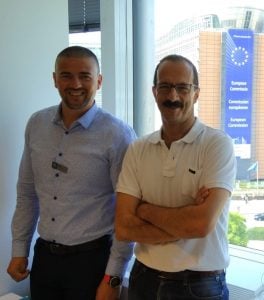Croatian PM2 team finished the translation of the overview, methodology and artefacts.
An interview with Marko Šimac -
Croatian Translation Project Lead
When and where did you first hear about PM²?
Everything started with the invitation to attend the Open PM² Conference in Brussels in 2018. I heard about PM², as an internal methodology for EU institutions, through the project management network. Watching it being rolled out into non-institutional contexts has been exceptionally interesting: I have to say that the energy behind the “open and common methodology” principle has been stunning.
What do you like about PM² and why do you think it is important to have it translated into your language?
The most recent enlargement of the European Union saw Croatia join the European Union as its 28th member state on 1 July 2013. Around 10 billion euro has been made available through 2014–2020, and another 9 billion euro will be available through ESIF for 2021–2027. If Croatia wants to capitalize on this opportunity, it is critical that it adopts new methodologies and processes to increase its project management maturity and the ability to coordinate EU-founded projects. Given the increasing number of projects, having a single ubiquitous and easy-to-use methodology like PM² is absolutely crucial.
We find the Open PM² methodology to be very light. It has many features which we can use to manage our projects, yet it isn’t weighed down by the paperwork, meetings and formalities required by other PM methodologies. It is wonderful that you can make your own workflows and take those parts of the PM² methodology you like and need for your project, while simply omitting those parts you don’t consider to be a good fit for your project and team.
The growing trend to apply agile management to projects that were not initially structured to be agile or lean has led to a situation in which you have project management “on paper”, but nothing at all in reality. It is easier to apply methodology when you have access to best practices, workflow charts and examples of standards to guide you and help you stay in control. PM² provides you with all of that: it extends to Agile, too, and aligns with lean practices, allowing you to mitigate problems of this kind.

How difficult was it to find qualified volunteers for the translation and how long did it take to complete the translation?
By the time the conference ended, I had already decided to make a Croatian-language translation. I delivered several presentations to the PM community in Croatia, and when I saw how much interest these generated, gathering a team together was easy. A few colleagues asked for help selecting and implementing PM methodology, and recommending PM² was a logical step.
Our young but experienced translation team was assembled from certified project managers working as consultants and lecturers, together with younger professionals with an interest in the project. We are all active in the IPMA and PMI associations.
When our English translator translated a section, I would align the terminology and forward it to the team to assemble. When the whole text was assembled, every team member read the text and commented on anything that wasn’t clear. This process was repeated several times until everybody was pleased with the result—an iterative pattern is clearly visible here!
We translated artefacts and graphics in parallel, what was a challenge because we only had pdfs to start with. Receiving the supporting files from the CoE team made everything a lot easier.
The translation was pretty high on our list of priorities, but we could only work on it for a limited number of hours per week, due to our other obligations. Every document was uploaded to the cloud, where it was accessible to every team member. When something was done, it was instantly available and visible to everybody in the team. It took us a few months to do everything from start to finish, with iterations. We needed approximately 4 hours a week per person on average over the 6 months.
What is the feedback you’ve received about PM² and your translation in particular?
The feedback so far has been very positive, and several public-sector enterprises have expressed an interest in introducing PM². Tomislav and I use it as teaching material at the several universities we deliver PM courses at, and the students love it. It is very adaptable and easy to implement. We even did the alignment with v3.0 published in October 2018, which we will be publishing and putting on our students’ obligatory reading lists. Beside the PM² methodology, we also translated the artefacts and graphics and the overview.
What do you think is the future of PM²?
I foresee a very bright future for PM², but the most important thing is that the PM² methodology—together with Portfolio Management and Agile—continues to develop and that we receive feedback from the organizations that implemented it. That the PM² methodology is now included in degree-level Management education is a good start, because it will make it very familiar to future users and give PM² a long lifecycle. Having a common project management praxis throughout the EU member states in a range of different contexts and conditions will increase the project, portfolio and strategy performance and success rate.
Croatian language translation team:
- Marko Šimac, PMI PMP, IPMA (Project Lead)
- Tomislav Rastovski, IPMA B
- Domagoj Knežević, IPMA D
- Neven Juranić
- Sara Lokmer
- Nicos Kourounakis (Coordinator)




